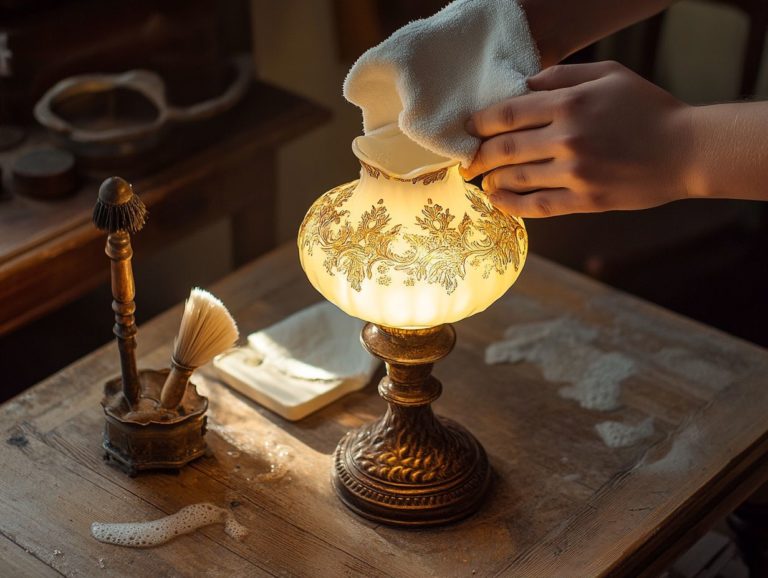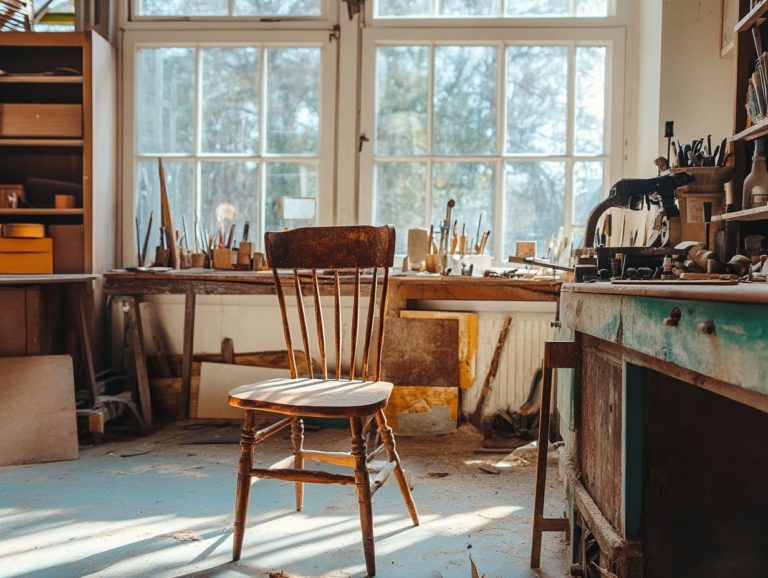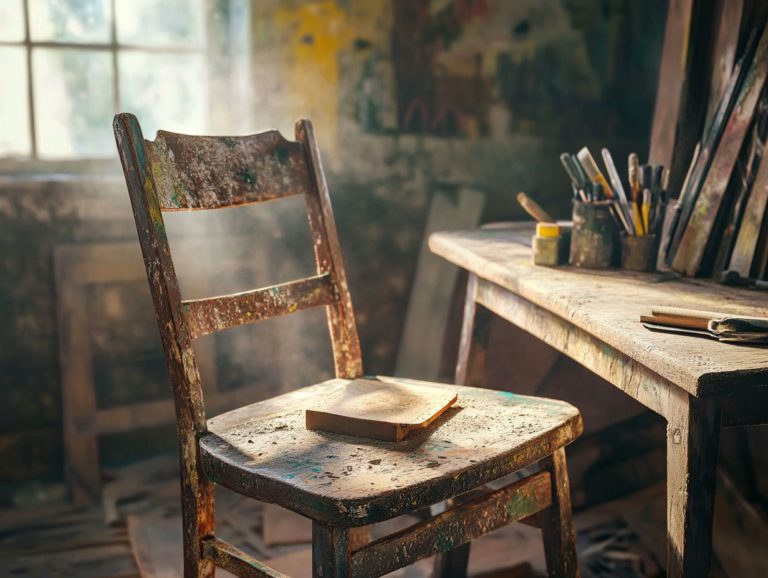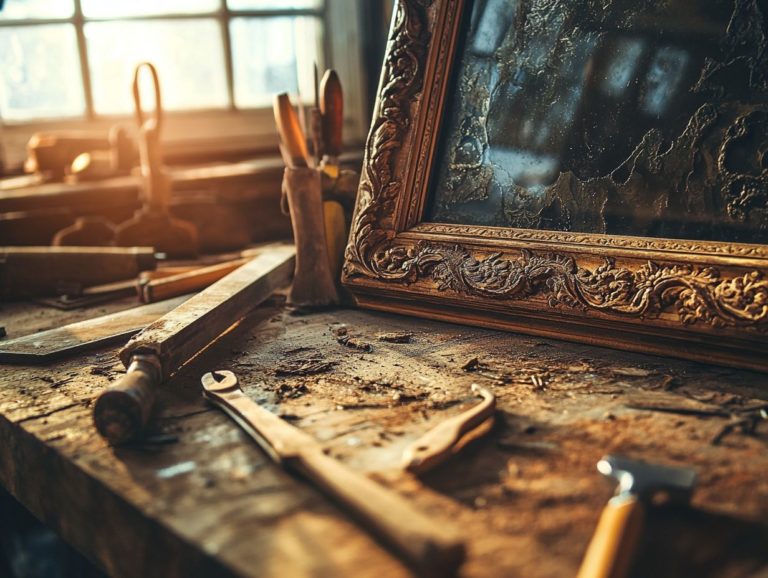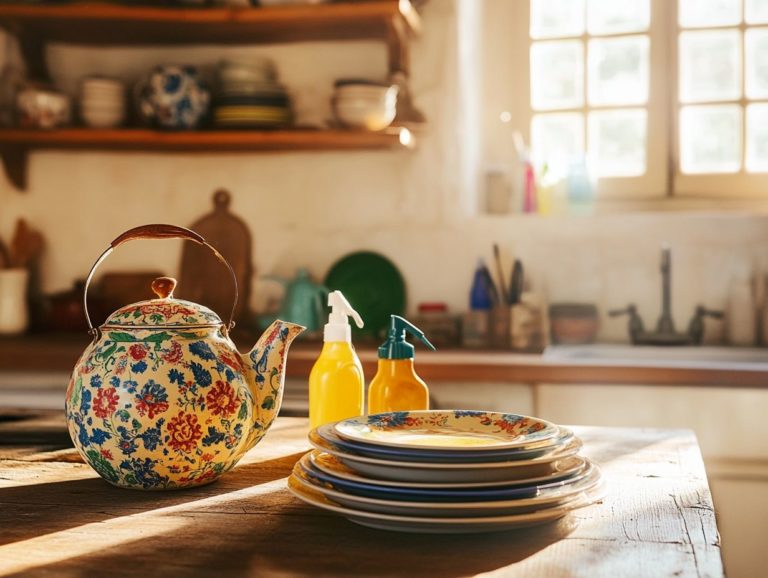How to Repair Vintage Sewing Machines
Vintage sewing machines possess a distinctive charm, seamlessly merging nostalgia with the artistry of craftsmanship.
Like any treasured antique, these machines may encounter a range of challenges over time. This guide will help you navigate the common issues that arise, providing insights from troubleshooting techniques to the essential tools required for repairs.
You ll discover a detailed step-by-step approach to disassembly, cleaning, and part replacement. Plus, you ll find valuable tips for ensuring your vintage machine remains in peak condition.
Embrace the delight of preserving a piece of history!
Contents
- Key Takeaways:
- Common Issues with Vintage Sewing Machines
- Tools and Materials Needed for Repair
- Step-by-Step Guide to Repairing Vintage Sewing Machines
- Tips for Maintaining and Preserving Vintage Sewing Machines
- Frequently Asked Questions
- What are some common issues with vintage sewing machines?
- How do I determine the age and model of my vintage sewing machine?
- Can I repair a vintage sewing machine myself?
- Where can I find replacement parts for my vintage sewing machine?
- What tools and supplies do I need to repair a vintage sewing machine?
- How often should I maintain and service my vintage sewing machine?
Key Takeaways:
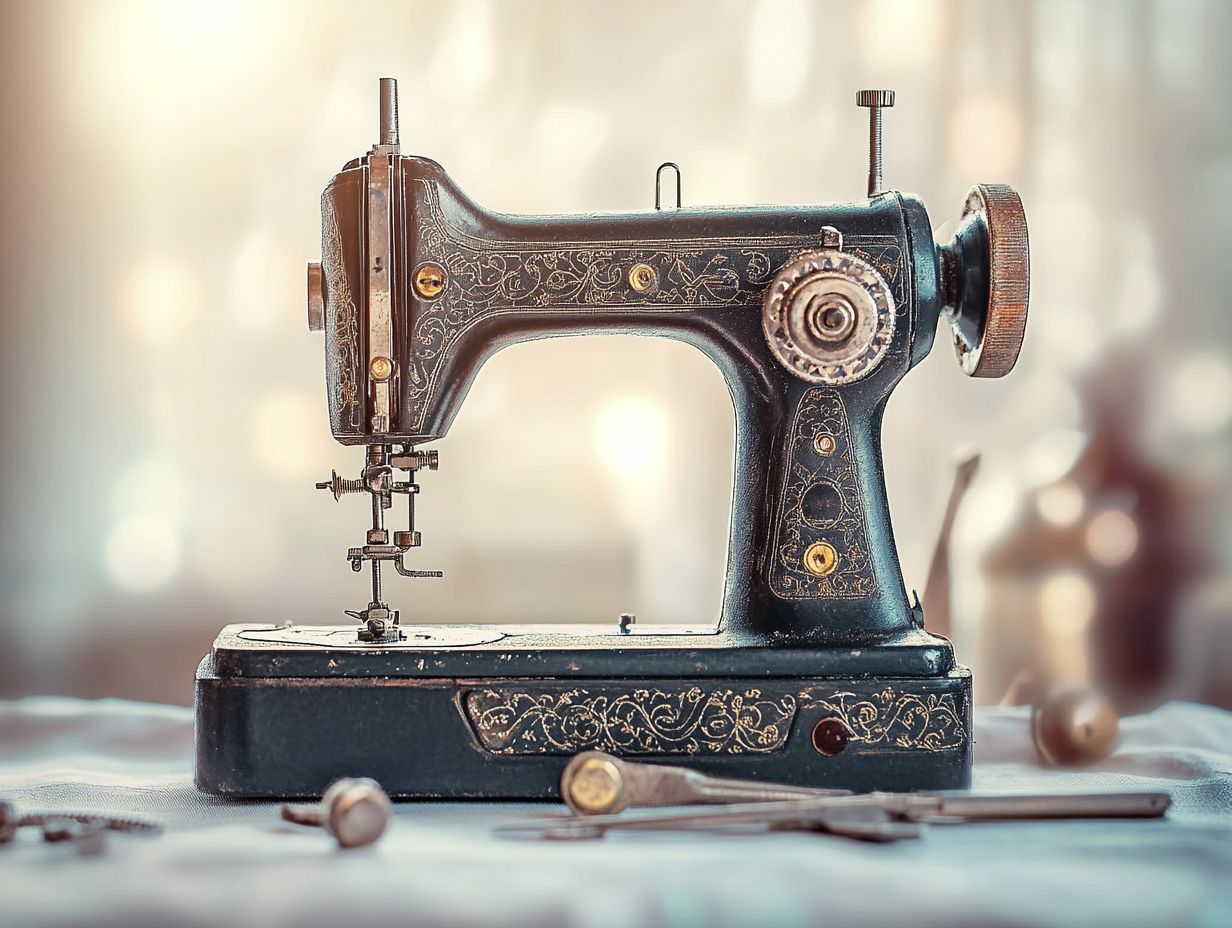
- Vintage sewing machines require special care and maintenance due to their unique features. Understanding their individual needs is crucial.
- Identifying and troubleshooting common issues is key to repairing vintage sewing machines. This allows for a more efficient repair process.
- Proper care and storage techniques are essential for maintaining and preserving vintage sewing machines. This ensures continued use and enjoyment of these unique pieces of history.
What Makes Vintage Sewing Machines Unique?
Vintage sewing machines, like those crafted by iconic brands such as Kenmore, Brother, Pfaff, and Singer, possess a distinctive charm and rich history that modern machines can t replicate.
Their designs often feature intricate detailing, with polished metal and wood finishes reflecting the exceptional craftsmanship of their era. The materials used in these vintage models like cast iron and robust steel were engineered for longevity, embodying the durability and reliability that older technology is known for.
You can feel the nostalgia in the air, as many owners treasure the stories woven into each thread. These memories stir fond recollections of family gatherings and lovingly crafted handmade gifts. Models like the Singer Featherweight and Pfaff 130 are celebrated not only for their quality and timeless elegance but also for their historical significance. They captivate enthusiasts who appreciate both their sewing prowess and their legacy.
By honoring this heritage, vintage sewing machines transform into more than mere tools; they become cherished heirlooms that connect generations through the art of stitching.
Common Issues with Vintage Sewing Machines
Vintage sewing machines possess an undeniable charm and functionality, yet they can often present a range of common issues that demand your attention for optimal performance. From thread tension troubles to a malfunctioning bobbin case, troubleshooting these classic machines can be both rewarding and challenging.
As a sewing machine owner, it’s vital to understand potential problems and the necessary repair techniques to achieve successful restoration and maintenance. Whether you re sourcing parts online or diving into a sewing machine manual, addressing these concerns will help you revive your vintage machines and bring them back to their former glory.
Identifying and Troubleshooting Problems
Identifying and troubleshooting problems in vintage sewing machines requires a systematic approach that targets common mechanical issues and their resolutions. Get to know your machine now to unlock its full potential!
Familiarizing yourself with the detailed parts of these machines enables you to effectively diagnose problems like thread jams, skipped stitches, or uneven tension.
Effective troubleshooting leads to better machine care, paving the way for longevity and optimal performance in your future projects.
To tackle these concerns, start by checking the threading of your machine. Ensure both the upper thread and the bobbin are properly positioned. Adjusting the tension settings can often resolve issues like skipped stitches or puckering fabric, so be sure to reference your machine manual for specific guidelines.
Regularly cleaning and oiling your machine is also vital; it prevents mechanical snags and enhances overall functionality.
Numerous online resources, from forums to video tutorials, provide step-by-step troubleshooting assistance and expert advice. These tools enable you to confidently enhance your skills while deftly resolving any hiccups you encounter in your sewing journey.
Tools and Materials Needed for Repair
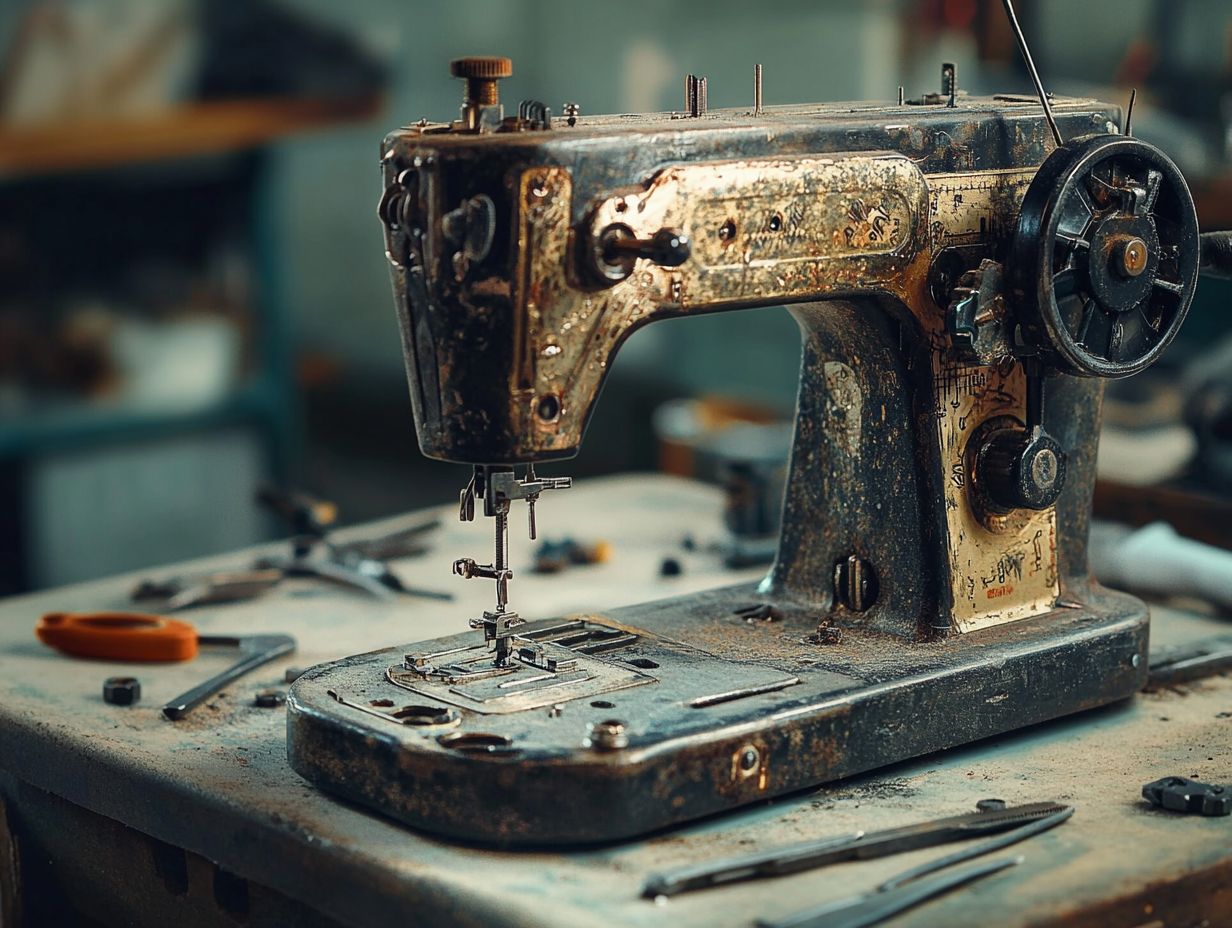
To successfully repair vintage sewing machines, you ll need a specific set of tools and materials that streamline the repair process and contribute to the machine’s longevity.
Essential tools for vintage sewing machines include screwdrivers and specialized cleaning brushes. High-quality sewing machine oil is critical for smooth operation.
Familiarizing yourself with the various supplies and accessories required for different repairs can significantly enhance the efficiency and effectiveness of your restoration efforts.
Essential Equipment and Supplies
Essential equipment and supplies for vintage sewing machine repair encompass a range of parts and tools specifically designed to tackle common issues and maintenance needs. A well-stocked sewing machine toolkit typically features screwdrivers, pliers, and an assortment of needles, complemented by essential cleaning materials such as brushes and oils.
Knowing which accessories to keep handy can make repairs faster. This knowledge helps prolong the life of your cherished machine.
Each item plays a pivotal role in your toolkit. For example, precision screwdrivers are designed for delicate tasks that require careful adjustments, while pliers provide the necessary grip for managing tiny parts. Specialized needles tailored for various fabrics can enhance sewing quality, particularly on vintage models. Handy tools like a stitch ripper or seam gauge are critical for maintaining your machine s performance.
You can source high-quality supplies from reputable craft stores or vintage markets, where fellow enthusiasts often share invaluable insights. Building a network of trusted suppliers ensures access to the best products for your vintage sewing endeavors.
Step-by-Step Guide to Repairing Vintage Sewing Machines
Get ready to dive into an exciting step-by-step guide that will help you restore vintage sewing machines to their glorious condition!
Grasping the sequential process of disassembling, cleaning, and troubleshooting is essential for anyone looking to refine their sewing machine skills.
This guide will lead you through the vital steps, from recognizing the need for repair to sourcing the appropriate parts, enabling you to embark on a rewarding journey of restoration.
Disassembling and Cleaning the Machine
Disassembling and cleaning your vintage sewing machine is a crucial step in restoring its functionality and performance. By carefully taking it apart, you gain access to internal components where dirt and residue have likely accumulated, which can hinder its performance.
Using the right cleaning techniques and high-quality sewing machine oil not only extends the life of your machine parts but also optimizes their operation, ensuring a smooth and enjoyable sewing experience.
To kick off the process, start by unplugging the machine and gathering your essential tools, such as screwdrivers and a specially designed cleaning brush. Wearing safety goggles is a must to protect your eyes from any debris while you work.
- Carefully remove the outer casing, making sure to note the order of disassembly to ease reassembly later on.
- Once you’ve got it open, use a microfiber cloth to gently wipe away dirt and lint, taking extra care around those delicate components.
- In terms of cleaning products, choose those specifically designed for sewing machines; harsh chemicals could cause damage.
Regular maintenance, like lubrication and cleaning, is essential for keeping your machine running smoothly and preserving its unique charm!
Now that you have the tools and steps for repair, it s time to bring your vintage sewing machine back to life let s get started!
Replacing Parts and Making Adjustments
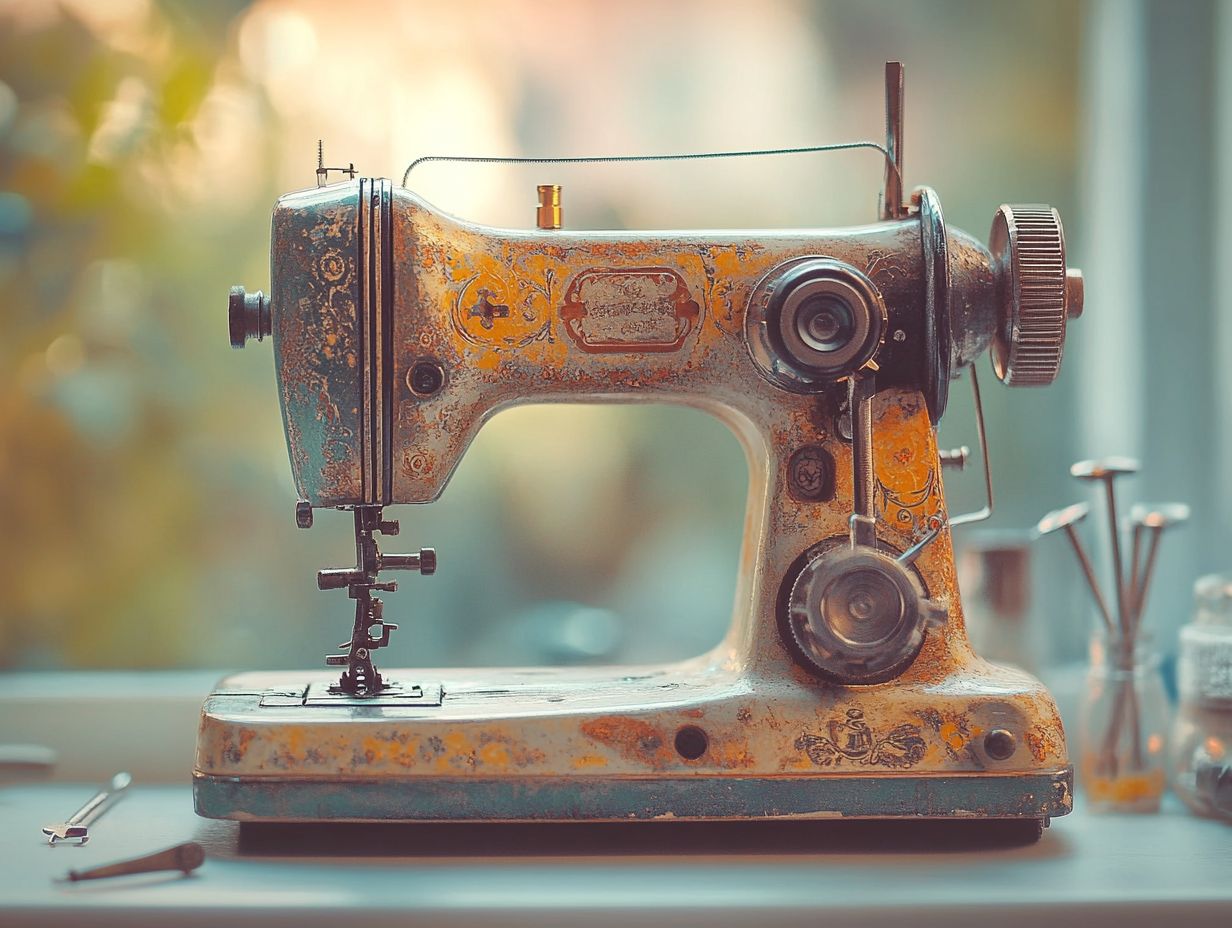
Replacing parts and making adjustments are essential tasks in sewing machine repair, particularly for vintage models that may have seen better days. Understanding how to identify which sewing machine parts require replacement is vital for any sewing enthusiast.
Knowing the adjustments needed for optimal performance is equally important. This process not only enhances the functionality of your machine but also elevates your overall sewing experience.
Start by assessing your machine for signs of wear, such as unusual noises, skipped stitches, or uneven feeding. Common issues often include:
- Frayed belts
- Dull needles
- Damaged bobbins
All of these can significantly impact performance.
Once you’ve pinpointed the troublesome parts, sourcing replacements can be easily done through specialized sewing machine suppliers or online marketplaces dedicated to vintage models. Be sure to have the correct part numbers handy to ensure compatibility.
After acquiring new components, make adjustments like adjusting the tightness of the thread and alignment to optimize sewing quality. When troubleshooting, remember that inconsistencies may arise from improper installation; double-check each step and consult manufacturer manuals for additional guidance to achieve peak performance.
Tips for Maintaining and Preserving Vintage Sewing Machines
Keeping your vintage sewing machines in top shape is an exciting way to preserve their charm! Engaging in regular maintenance routines, such as:
- Cleaning
- Oiling
- Proper storage
is crucial in preventing wear and tear. Follow expert care guidelines and utilize the resources available for sewing machine upkeep to restore these timeless machines and keep them in pristine condition.
Proper Care and Storage Techniques
Proper care and storage techniques are essential for preserving both the functionality and aesthetic charm of your vintage sewing machines. By employing effective maintenance practices, like keeping your machine clean and well-lubricated, you significantly enhance its longevity.
Implement proper storage methods, such as using protective covers and avoiding extreme temperatures, to prevent damage and deterioration over time.
Investing in high-quality sewing machine supplies, including specialized oils and cleaners tailored for vintage models, can greatly enhance performance and ensure efficient operation. Regularly inspect belts, needles, and other critical components for wear and tear, replacing them as needed to maintain optimal functionality.
Storing your machine in a dust-free, climate-controlled environment preferably within a sturdy cabinet or case is crucial. By following these practices, you safeguard the machine’s functionality while preserving its aesthetic value, ensuring it remains a cherished heirloom for generations to come.
Benefits of Owning and Repairing Vintage Sewing Machines
Owning and repairing vintage sewing machines offers an array of benefits that go beyond mere functionality, transforming your experience into something truly rewarding. These machines carry a rich history and a unique character that modern counterparts often lack, providing you with a chance to connect with the craftsmanship of the past.
Engaging with the sewing machine community allows you to gain valuable insights and shared experiences that enhance the joy of your sewing journey. The satisfaction you derive from restoring these historical pieces often transcends the simple act of sewing; it forges a tangible link to generations of artisans who traveled a similar path.
You ll likely find yourself captivated by the stories behind each machine who used it, the purposes it served, and the creative breakthroughs that were achieved. A treasure trove of resources, such as forums, social media groups, and detailed manuals, awaits to help you preserve and appreciate these vintage wonders.
This supportive network not only shares technical tips for maintenance but also hosts events and gatherings, allowing you to connect with fellow enthusiasts, trade insights, and celebrate your shared passion.
Frequently Asked Questions
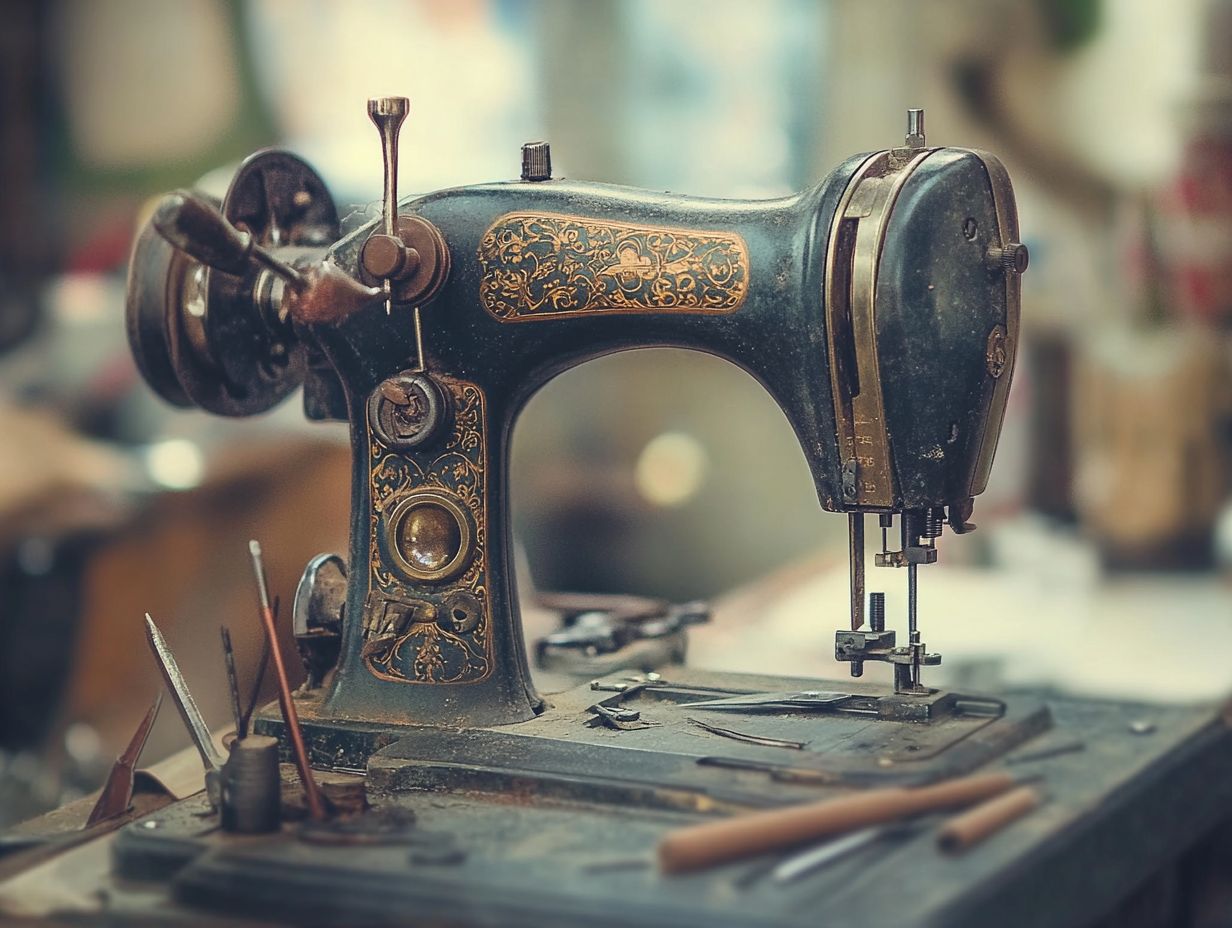
What are some common issues with vintage sewing machines?
Common issues include rust, broken or missing parts, and lack of maintenance. These can lead to jamming or tension problems.
How do I determine the age and model of my vintage sewing machine?
You can find the age and model by checking the serial number in a database or contacting the manufacturer. You could also talk to someone who knows about sewing machines or refer to books.
Can I repair a vintage sewing machine myself?
If you have some experience with sewing machines, you might be able to repair it yourself. If you’re unsure, seek professional help.
Where can I find replacement parts for my vintage sewing machine?
Discover great replacement parts online today from sewing machine retailers or vintage collectors. You can also check sewing machine repair shops or antique shops.
What tools and supplies do I need to repair a vintage sewing machine?
Essential tools include screwdrivers, pliers, sewing machine oil, cleaning brushes, and specific replacement parts. A manual for your sewing machine model may also be helpful.
How often should I maintain and service my vintage sewing machine?
Maintain and service your machine at least once a year, even if you rarely use it. Regular maintenance helps prevent larger issues and keeps your machine in good working condition.

